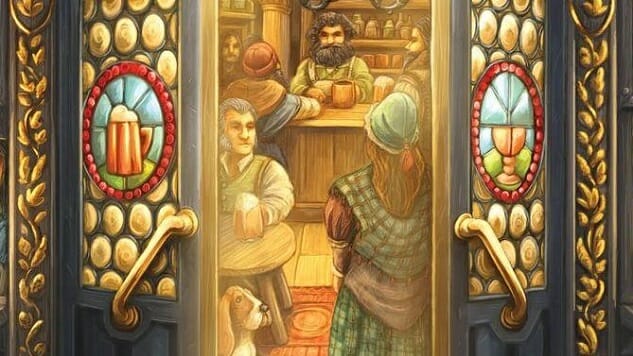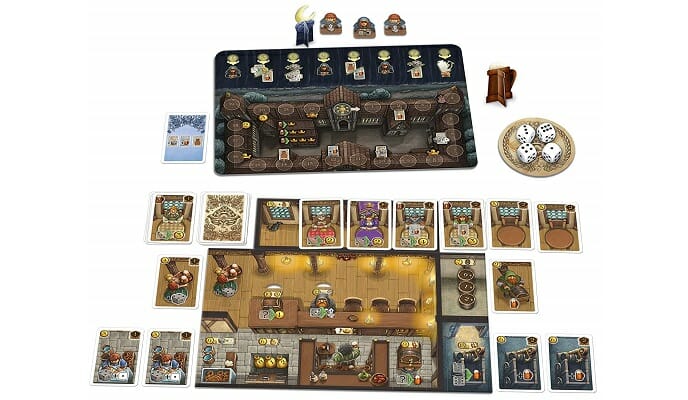Beer-Soaked Board Game The Taverns of Tiefenthal Is One of the Year’s Best
Art courtesy of North Star Games Games Reviews board games
If you couldn’t get enough of the Quacks of Quedlinburg, allow me to introduce you to (checks notes) the Taverns of (checks spelling, again) Tiefenthal.
Designer Wolfgang Warsch won the Kennerspiel des Jahres in 2018 for The Quacks of Quedlinburg, a quirky push-your-luck game that featured a lot of simultaneous play to keep things moving quickly, with entire games coming in consistently under an hour. He also earned nominations that year for two lighter games, the cooperative game The Mind and the roll-and-write That’s So Clever, and released an underrated co-op game in the Pandemic mold called Fuji. He’s now returned to his line of alliterative, more complex games with The Taverns of Tiefenthal, a hybrid dice-drafting/deckbuilding game that gives you lots of choices on each turn, also includes simultaneous play, and comes with four additional ‘modules’ that let you tune up the complexity of the game to suit your style.
Each player gets a modular tavern board, with 10 interlocking pieces that show different powers on both sides. You start the game with all of those pieces on their simpler/lower-powered sides, but may upgrade them over the course of the game’s eight rounds. Each player also starts with a deck of 10 cards: seven tavern guests, a server, an extra table, and a brewer. You shuffle that deck and start dealing out cards to your tavern until all three of your tables are occupied by guests (four, if you happen to deal your table card in that round, as that can accommodate another guest).
Then the fun with dice-rolling begins. Each player gets four white dice to roll and places them on the coaster after rolling. If you happened to draw a server card that round, you get a bonus die in your specific color and can roll that as well. Everyone takes one of the white dice they rolled and places it by their tavern—you can put it on a specific slot, but can also freely move them later—and then passes their coaster of remaining dice to the next player, with everyone drafting and passing until all of the dice are taken.
Every spot on the board and every guest card has some kind of function tied to dice placement, with most of them requiring specific face values. Every guest card requires a die of a certain value, one through five, and then gives you coins (Thalers) of that quantity in return. The brewery lets you place a die of value one or six there, and returns one beer per die, or more if you also drew a brewer card in that round. The monk lets you move up the game’s advancement track for every die of value five you place there. Other spots only take one die but can hold any value, giving you one Thaler or one beer in return. Once you’ve placed all your dice, you will get some quantity of Thalers and some quantity of beer to spend in that round. You can buy upgraded cards—servers, brewers, tables, dishwashers (one dishwasher can add one to the value of a single die), or barbacks (one beer when drawn) with Thalers, or spend your Thalers to upgrade (flip) part of your tavern. You can use beers to purchase new guest cards, as little as three for the worst guests, and high-value noble cards if you get nine beers in a turn.

Your ultimate goal is victory points, and nearly all of those will come from noble cards, which are all identical and are worth 10 points at game-end. You get a noble card when you upgrade any part of your tavern, and you can buy them outright for beer. Noble cards go into your deck, but unlike other guest cards, they stack when drawn—all the noble cards you draw in a round sit at one table, so they don’t clog up your deck the way that guest cards can. Upgrading your tavern is thus key for gaining points, and also makes your tavern more powerful—giving you an extra table, or a permanent server/dishwasher, or allowing for more beer/money storage. You can also discount the cost of some upgrades if you return matching cards to the supply; for example, if you drew a table on a turn, you can trash that table card and take five coins off the cost of upgrading that component. It’s nearly always worth it to upgrade, even though it makes your deck a bit worse in the short term, between the points you gain and the additional abilities.
The game has a lot of rules, but the turns themselves move quickly, and there’s a clear rhythm to the turns that became apparent after our first complete play-through. The base game is clearly just that, as the modules give you a lot more flexibility; my guess is that Warsch wanted more of this stuff in the base game and was advised against what would have been an overwhelming set of rules had he done so. The first module introduces Schnapps tokens and entertainers; you get additional, permanent powers you can use by paying back Schnapps tokens, although your ability to get more of those is limited. The most powerful of those is the ability to permanently remove guests from your deck, which is hard to do in the original game but which you can do three or four times in the first module; it’s a great way to get rid of the least valuable guests (the #1 guests, who return just a single coin when you place a die on one) and build a leaner deck that allows you to cycle through most of it in each turn. The second module gives you a ‘reputation track’ that you can move around repeatedly, gaining more schnapps and potentially removing another guest card once per circuit; of the four modules, this introduces the biggest changes to gameplay and strategy.
Warsch’s best trick as a designer is that he manages to create games that involve a lot of rules and require a fair amount of thinking but that are undeniably fun. The Taverns of Tiefenthal is kind of imposing, maybe a bit too convoluted in parts, but it is absolutely fun. There are certainly tweaks to the rules I’d love to see—the game needs to give you more ways to manipulate dice values, for one thing, as it’s way too easy to end up with few or no legal moves—but the interaction of dice and deck, and of figuring out what dice might come your way each turn, is like an intricate puzzle that will be different every game because of the randomness of the dice and of the guest cards available to purchase. I also particularly liked the artwork, which reminds me of some of my favorite CPRGs over the years, from The Bard’s Tale to the original Baldur’s Gate (the tavern here could easily be the first floor of the Friendly Arm Inn), although some of the cardboard pieces don’t fit together cleanly when you assemble your personal tavern board. It made my top 10 games of 2019 even though I’d just scratched the surface while playing it, and now after many more plays, I’m even more of a fan. There’s a lot going on here, and that makes it one of the most replayable games of the last year.
Keith Law is the author of Smart Baseball and a senior baseball writer for The Athletic. His latest book, The Inside Game, is due out in April 2020. You can find his personal blog the dish, covering games, literature, and more, at meadowparty.com/blog.